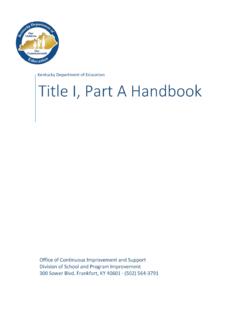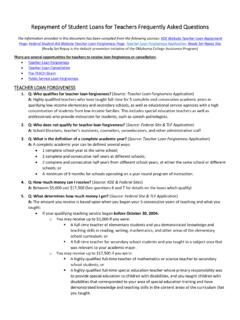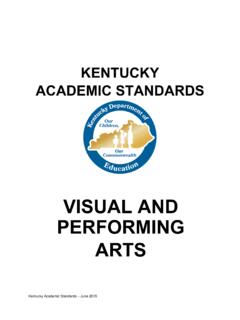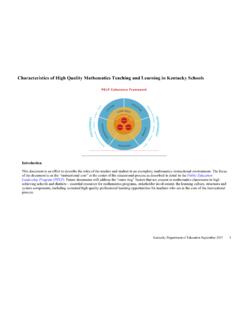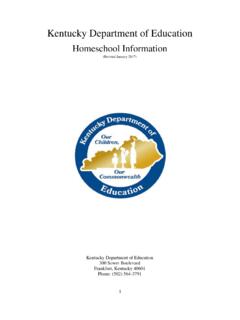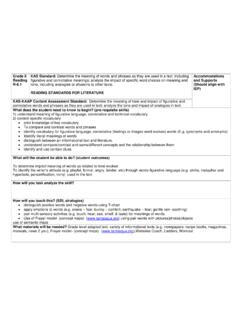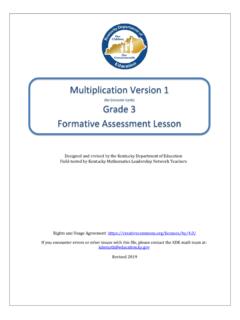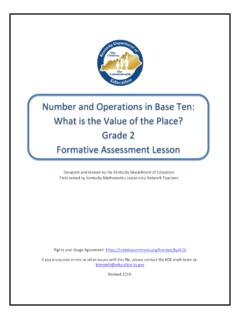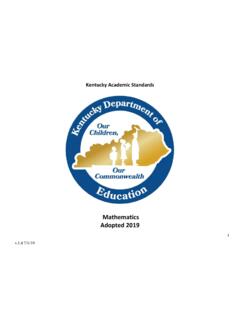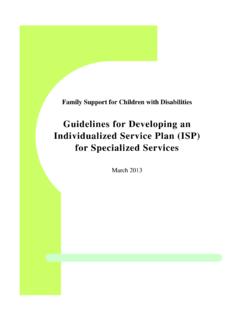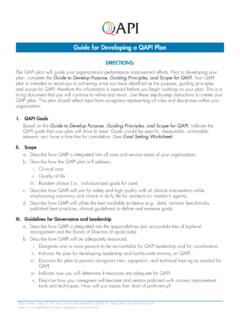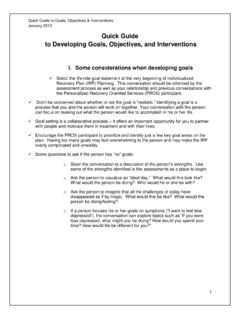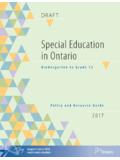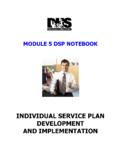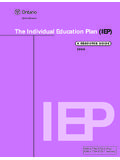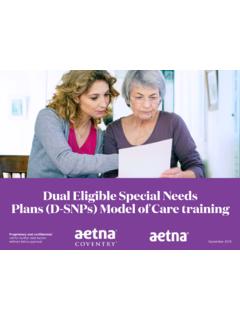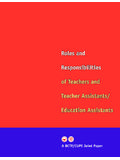Transcription of IEP Guidance Document July 2018
1 Guidance Document for Individual Education Program (IEP) Development July 2019 Revisions to Guidance documents occur based on feedback the Office of Special Education and Early Learning (OSEEL) receives from the Directors of Special Education, state shareholder groups, the KDE s interpretation of law, court cases and Guidance from the Office of Special Education Programs (OSEP). The OSEEL also revises Guidance documents based on on-site monitoring visits, desk audits and formal written complaints. 1 TABLE OF CONTENTS PURPOSE OF THE Guidance Document FOR THE IEP ..4 INTRODUCTION TO STANDARDS-BASED IEPS.
2 4 INDIVIDUAL EDUCATION PROGRAM (IEP)..6 USING STUDENT PERFORMANCE DATA FOR IEP DEVELOPMENT ..8 INITIAL ELIGIBILITY ..8 ANNUAL REVIEWS ..8 PRESENT LEVELS OF ACADEMIC ACHIEVEMENT AND FUNCTIONAL PERFORMANCE ..10 PREPARATION FOR IEP DEVELOPMENT ..11 STEPS FOR WRITING THE PRESENT LEVELS ..11 STEPS FOR COMPLETING PRESENT LEVEL AREAS ..12 QUESTIONS TO CONSIDER ..12 PRESENT LEVELS GUIDING PRESENT LEVEL AREA: COMMUNICATION PRESENT LEVEL AREA: ACADEMIC WRITTEN EXPRESSION: GENERAL GUIDING QUESTIONS ..18 MATHEMATICS: GENERAL GUIDING QUESTIONS ..20 PRESENT LEVEL AREA: SOCIAL AND EMOTIONAL STATUS ..25 PRESENT LEVEL AREA: GENERAL PRESENT LEVEL AREA: TRANSITION NEEDS ..30 PRESENT LEVEL AREA: FUNCTIONAL VISION AND LEARNING MEDIA PRESENT LEVEL AREA: FUNCTIONAL HEARING, LISTENING AND COMMUNICATION ASSESSMENT ..34 CONSIDERATION OF SPECIAL FACTORS FOR IEP MEASURABLE ANNUAL GOALS.
3 40 STEPS FOR WRITING STANDARDS BASED MEASURABLE ANNUAL METHOD(S) OF MEASUREMENT ..44 BENCHMARKS/SHORT-TERM INSTRUCTIONAL POSTSECONDARY AGE OF REPORTING SPECIALLY DESIGNED INSTRUCTION ..51 SUPPLEMENTARY AIDS AND services ..52 ASSESSMENT ALTERNATE ASSESSMENT ..55 PROGRAM MODIFICATIONS AND SUPPORTS FOR SCHOOL PERSONNEL ..56 LEAST RESTRICTIVE SPECIAL EDUCATION services ..60 IEP SPECIAL EDUCATION RELATED services ..62 IEP RELATED services - EXAMPLES ..63 EXTENDED SCHOOL YEAR PROGRESS MONITORING ..66 2 EXAMPLES OF PROGRESS MONITORING METHODS OF MEASUREMENT ..68 COLLECTING, GRAPHING AND INTERPRETING PROGRESS DATA TO MAKE INSTRUCTIONAL DECISIONS ..68 USING DATA TO REPORT PROGRESS TO END OF IEP CYCLE (ANNUAL REVIEW ANALYSIS) ..69 APPENDIX A: SAMPLE MEASURABLE VERBS.
4 70 APPENDIX B: KDE CLARIFICATION EMAIL FROM AUGUST 2004 ..71 APPENDIX C: TEACHER RESOURCES FOR WRITING ANNUAL APPENDIX D: PRESENT LEVELS GLOSSARY ..73 APPENDIX E: KDE/OVR TRANSITION IEP Guidance 3 Purpose of the Guidance Document for the IEP The Guidance Document for the IEP provides instructions and examples for developing IEPs for Admissions and Release Committee (ARC) members, including chairpersons, teachers, related service providers and parents. The Document is to be used in conjunction with the following: federal and state statutes and regulations, including Individuals with Disabilities Education Act (IDEA) statute and regulations and the Code of Federal Regulations (CFR) Kentucky Revised Statutes (KRS) Title XIII (Education) Kentucky Administrative Regulations (KARs) Compliance Record Review Document local district policies and procedures The Guidance Document for the IEP is dynamic in nature.
5 As resources emerge from the federal Office of Special Education Programs (OSEP), KDE and the Special Education Cooperatives, updates to the Document will be posted on the KDE website. The Document is reviewed yearly and revised as needed. Introduction to Standards-Based IEPs The 1997 Reauthorization of the IDEA and the subsequent 2004 Reauthorization of IDEA mandated that students with disabilities gain access to the general education curriculum. The No Child Left Behind Act of 2001 (reauthorized as Every Student Succeeds Act in 2015) required ARCs to ensure students with disabilities have access to the general education curriculum to the greatest extent possible. A key purpose of IDEA, as set forth in the IDEA Regulations Part B, Subpart A, Sec. (a) is to ensure that all students with disabilities have available to them a free appropriate public education (FAPE) that emphasizes special education and related services designed to meet their unique needs and prepare them for further education, employment and independent living.
6 In 2014, the Department of Education implemented a revised accountability system under the IDEA known as Results-Driven Accountability (RDA). This initiative shifted the Department s accountability efforts from a primary emphasis on compliance to a framework that focuses on improved results for students with disabilities. RDA emphasizes child outcomes such as performance on assessments, graduation rates, and early childhood outcomes. IDEA reauthorization and initiatives at the federal level have reshaped IEP development. Kentucky adopted state standards in 2010, these were updated in 2015 as the Kentucky Academic Standards (KAS). The KAS for reading and writing, mathematics, health education and physical education have since been revised for the 2019-2020 school year. "Access to the general curriculum is focused on the KAS.
7 For students pursuing an alternate course of study, in addition to the KAS, the resources below serve as curriculum Guidance for developing IEPs based on academic, functional and transition skills. Health Education and Physical Education-Curriculum Documents and Resources Career Studies-Curriculum Documents and Resources Kentucky Alternate Assessment aligned to Kentucky Academic Standards (KAS) Kentucky Employability and Foundational Academic Standards 4 The Kentucky Early Childhood Standards (KYECS) is the curriculum Document for preschool. KYECS is designed as a framework to assist in understanding what children should know and be able to do from birth through four years of age. The KYECS provides a common set of expectations for young children and represents the skills and knowledge that provide the foundation for school readiness.
8 The standards are critical for ensuring later academic success. 5 Individual Education Program (IEP) The IEP is a written program for a student with a disability who is eligible to receive special education and related services under the IDEA. The IEP describes the student s strengths and needs, and articulates measurable annual goals, specially designed instruction, related services , and supplementary aids and services required to address the educational needs of the student. The student's ARC is responsible for developing the IEP, ensuring IEP implementation, reviewing progress toward the measurable annual goals and revising the IEP as appropriate. Parent input in IEP development and revision is an important requirement.
9 The ARC solicits parent concerns and input through parent participation in the ARC process, or by other means, if the parent is unable to participate in the ARC meeting. IEP and other required due process forms are found in Kentucky s Student Information System, Infinite Campus (IC). The KDE updates IC Data Standards annually. Federal regulations (CFR) and state regulations (KAR) specify requirements for the IEP process. 1. The IEP supports learning by: providing access to the general curriculum (KAS & KYECS) ensuring the student will participate in developmentally appropriate activities ensuring the student will make progress in the general curriculum (educationally, academically, behaviorally and functionally) addressing the student s other unique educational needs preparing the student for further education/training, employment and independent living Source regulations: 707 KAR 1:320 5(7)(b)(1-2); 34 CFR (a)(4) 2.
10 At least once every 12 months (365 calendar days), the ARC reviews the IEP and accompanying ongoing progress data to determine whether the measurable annual goals are being achieved. The ARC then revises the IEP, as appropriate, to address: progress towards the measurable annual goals progress in the general curriculum, if appropriate the results of any reevaluation (if appropriate) information about the student provided by or to the parents the student s strengths and anticipated needs other matters Source regulations: 707 KAR 1:320 2(6); 34 CFR (b)(1) 3. The ARC shall consider in the development of an IEP: the strengths of the student the concerns of the parents for enhancing the education of their student the results of the initial or most recent evaluation of the student the academic, developmental and functional needs of the student Source regulations: 707 KAR 1:320 5(1); 34 (a)(1) 6 7 Using Student Performance Data for IEP Development Source regulations: 707 KAR 1:320 5(1), 34 CFR (a)(1), 707 KAR 1:300 4(10), 34 CFR (c)(4) Student performance data reflects student performance in both academic and non-academic areas.
